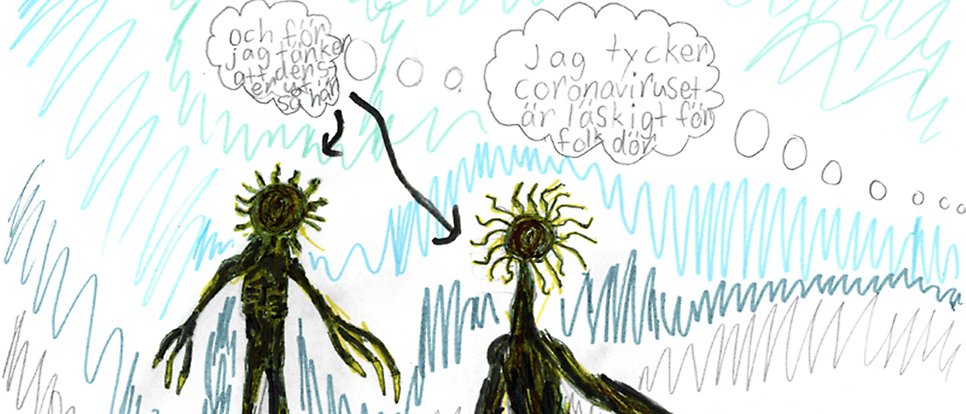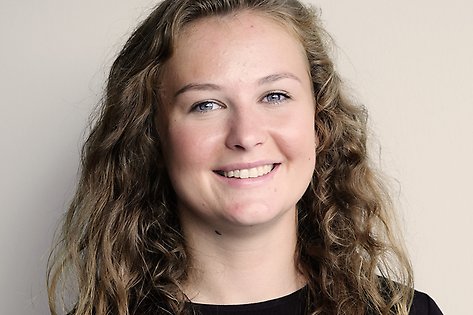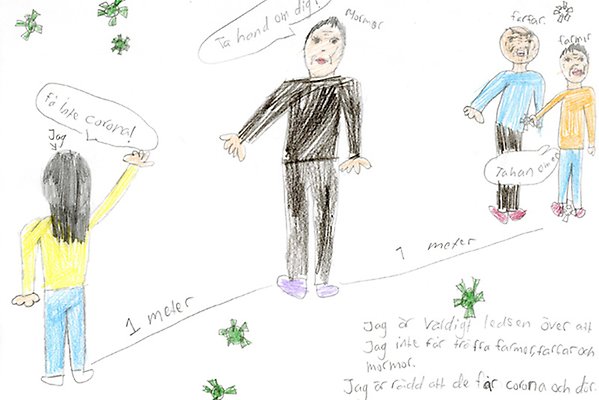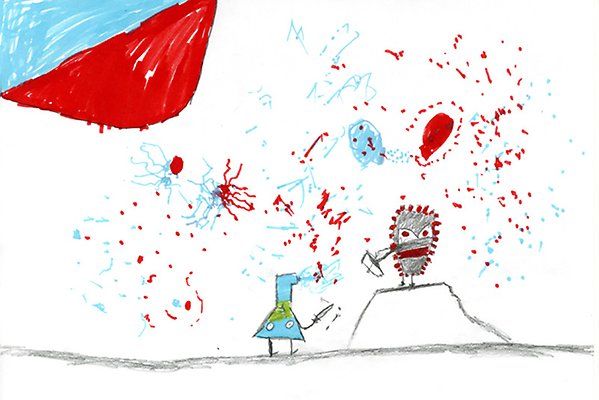Drawings reveal children’s experiences of the pandemic

Image: SBBA_2020_009_0139. Swedish Children’s Picture Archive. The pictures that have been analyzed in CHAP's study are drawn by 7-11-year-olds and show their experiences of the pandemic.
Children understood and worried more about the pandemic than we might have thought. That’s the finding of a study conducted by the research group CHAP at the Department of Public Health and Caring Sciences on behalf of the Public Health Agency of Sweden.

Sofia Gjertsson, Research Assistant at the research group CHAP.
CHAP has contributed two sub-studies to the Public Health Agency’s report “The Consequences of the Pandemic for Children and Young People.” In one, researchers examined over 450 children’s drawings, by children aged 7–11 years, collected by the Swedish Children’s Picture Archive during 2020–2021.
“Our research group has previously conducted studies on drawings by younger children, and we knew that this valuable material was available at the Swedish Children’s Picture Archive. Often, images are a good way to convey children’s own thoughts, feelings, and opinions rather than through text and speech. Here, we also had brief descriptive texts accompanying the drawings, which we analysed together with the pictures,” explains Sofia Gjertsson, research assistant at CHAP and one of the authors of the study.
Anger and frustration were surprising
The results of the analysis partially confirmed previous perceptions, including that children have a good understanding of events happening in the society around them.
“In general, children showed a very good understanding of what the pandemic meant, how the virus spread, where the pandemic started, which countries were most affected, and various societal restrictions. Overall, the children demonstrated a significant health literacy, which we have also seen in previous similar studies,” Sofia states.

Image: SBBA_2020_009_0548. Swedish Children’s Picture Archive. Frustration and sadness at not being able to see loved ones was evident in several drawings.
However, there were several surprising results.
“What we perhaps didn’t expect to find was the anger and frustration conveyed in the drawings, but also concern for others besides themselves. A consistent theme was concern about infecting an older relative.”
“We have seen that the relationship with grandparents is very important to children, and not being able to meet them was a source of great frustration for many children. Furthermore, we could also see how much children’s independence means even at an early age, where autonomy is not yet so great. The things they still get to decide on, such as leisure activities, are very important. It was often in relation to such matters that we could see anger and frustration.”
How would you describe children’s perception of the virus?
“For some, the virus became like a ‘creature’ that was ‘evil’ or ‘bad’. There were many terms reminiscent of fairy tales and other contexts where one is either evil or good. For example, there were drawings showing how the good fight against the evil Covid,” recounts Sofia Gjertsson.

SBBA_2020_009_1091. Swedish children's picture archive. The virus was often portrayed as ‘evil’ or ‘stupid’, and something that the ‘good guys’ needed to fight against.
Even though the virus was personified as evil, it doesn’t seem like the children felt any great fear.
“There was a fear of the virus, but that fear was less about them getting sick themselves. Where we saw the most impact on the children was the societal consequences following Sweden’s still relatively mild restrictions, such as cancellation of leisure activities or not being able to meet relatives and friends.”
“Children need to be included”
The authors of the study, including Sofia Gjertsson, have drawn several conclusions that can lead to important lessons for the future. Not only in potential health crises, but also in other societal crises that may arise.
“What we have seen is that children have a surprisingly strong ability to see things beyond themselves – that they actually understand a lot about the world around them. We believe it’s important to take this into account and that children should be more included in such societal issues. Targeted efforts are needed for children to feel involved,” Sofia asserts, continuing:
“The pandemic was a crisis that now, to a large extent, lies behind us. But we see how other crises, such as conflicts in our vicinity and natural disasters, arise. It’s important that children are included in issues and contexts related to this, so that they feel included in matters that actually concern them, as well as adults. After all, it’s the children who will grow up with the legacy we leave behind. Therefore, we see it as important that we not only do things for or about children, but WITH children.”
Robin Widing
About the study
The study examined how children aged 7–11 in Sweden were affected by the COVID-19 pandemic, using drawings created by the children themselves. Over 1200 images were collected from across the country by the Swedish Children’s Picture Archive during 2020–2021, and 454 of these images, drawn by 7–11-year-olds with accompanying texts, were included in the study.
Top analyse the material, a qualitative method involving content and semiotic visual analysis was used. The analysis underwent four steps, beginning with an examination of the content of the images. Next, the images were categorised based on what the children had drawn. Step three involved an analysis of the texts that the children themselves had written or dictated to an adult, which were often found on the back of the drawings. Finally, image and text analysis were combined in an interpretation to understand both the content and meaning of the drawings.
The analysis generated seven themes: Children’s perceptions of COVID-19; Prohibitions evoke strong emotions; COVID-19 leads to illness and death; Ways to protect oneself and reduce transmission; The whole world is affected; Existential thoughts; and finally Contrasts.
About CHAP
The research group CHAP is an international and interdisciplinary research group focusing on improving the mental health and well-being of children, youth and parents, through science, clinical development, and translational work.
The group is led by Professor Anna Sarkadi, Specialist Physician and Professor of Social Medicine and Public Health at Uppsala University. The group consists of people with backgrounds in psychology, public health, medicine, health economy, and social-, behavioural-, and nursing science.
Read more
How the pandemic affected children and the young (Swedish only)
Report: The consequences of the pandemic on children and the young (Swedish only)
